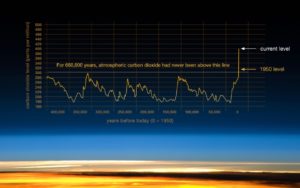
The rising global temperatures
April 9, 2020
Paris Agreement on climate change
April 9, 2020Many policymakers are fighting to limit the rise in average global temperatures to two degrees Celsius. Even the 0.85% rise in average global temperatures we experience today is making life rather unbearable. Imagine how the world will be if our daytime temperature rises by another degree and a bit permanently. This article gives an overview of how the Earth’s historical temperatures have been estimated, and the consequences of even a two degree rise in average temperature.
Among many climate scientists, 2° Celsius is a magic number. If average global temperatures were to rise by 2° Celsius (3.6° Fahrenheit) from the pre-1880 level, which was the start of the industrial revolution from when fossil fuel burning has steadily risen, most climate scientists say that there will be devastating and irreversible outcomes to the climate of our planet Earth. They estimate that the long term temperature pattern of the planet has already deviated by 0.85° Celsius (1.5° Fahrenheit) since 1880. It is generally agreed amongst scientists that this climate warming trend is very likely a result of human activities. Unfortunately, there is still a segment of policy makers and politicians, such as the US Presidential candidate Donald Trump, which claims that global warming is a hoax.
Over the last 650,000 years alone, it is believed that the glaciers have advanced (called ice age) and retreated seven times. Present day humans (Homo sapiens sapiens) evolved around 200,000 years ago. Since the last ice age ended about 10,000 years ago, about which time human civilisation started, the Earth’s temperature has only fluctuated by one degree Celsius. The sceptical person may wonder how the long term temperature variations were determined in the first place as the Earth’s climate has always changed. On the one hand, atmospheric samples in ice cores, and sediments and deposits laid down over hundreds of thousands of years have given scientists an indirect means of estimating past climate fluctuations through simulations. On the other hand, a variety of methods including thermometers on land and sea, weather balloons and satellites have allowed measurements to be taken in recent times.
The graph below shows the estimated concentration of carbon dioxide in the Earth’s atmosphere over the last 650,000 years. The rising global temperatures are due to the increase concentration of greenhouse gases (GHG) in the atmosphere. Of these, the largest contributor is carbon dioxide (CO2) followed by methane (CH4) and sulphur dioxide (SO2). Studies have shown that the rise of carbon dioxide levels in the atmosphere over the last 1,300 years, and its unprecedented rate, is very likely a result of the expansion of human civilisations. Evidence from ice cores in glaciers has also provided empirical evidence to support the claim that the Earth’s climate responds very quickly to changes in GHG levels; it only takes a couple of decades for significant climatic changes to occur.

This graph, based on the comparison of atmospheric samples contained in ice cores and more recent direct measurements, provides evidence that atmospheric CO2 has increased since the Industrial Revolution.
Source: NASA Global Climate Change
Based on: Vostok ice core data/J.R. Petit et al.; NOAA Mauna Loa CO2 record.
So why is the 2° Celsius important? In 1977, a Yale economist named William Nordhaus in a paper titled Economic Growth and Climate: The Carbon Dioxide Problem first suggested these two-degrees as the limit the present human civilisation can sustain itself. The two-degrees have since become the widely accepted benchmark for sustainable development although many others still consider this figure to be insufficient as Nordhaus’s limit is not backed by scientific studies. Even the 0.85° Celsius rise experienced at present is said to have caused significant climatic changes. It is no coincidence that 2014 and 2015 had been recorded as the hottest years recorded to date. This pattern of record temperatures has flowed over into 2016 as well. We have witnessed widespread mayhem as a result of variations in weather patterns in recent years including unexpected and devastating floods across several cities in the world. The greater frequency and greater force by which we experience extreme weather conditions lend support to the possibility that the Earth’s climate is already changing at a fast rate.
To emphasise, a two degrees variation is still dangerous, and many scientists feel one-degree should be the limit. For starters, the global temperature during all of human existence has been within the one-degree limit. If the earth’s temperature rises by two-degrees, we can expect longer droughts and more intense heat waves. The World Wide Fund for Nature (WWF) estimates that between 20 and 30 per cent of the planet’s animals and plants would disappear. There would surely be large disruptions in the global food supply. A recent research paper published in the journal Nature predicts that the Antarctic ice shelves would collapse, resulting in a rise of up to 10 meters above the present sea levels. As about 10 per cent of the present global population of 7.2 billion presently live below 10 meters, the outcome would certainly cause unprecedented migrations of people across countries.
The image below shows the effect of a rise in sea levels on the Malaysian coast line. Even a five meter rise in sea levels will submerge is significant portion of the coastline of the northern states of Peninsular Malaysia, Sabah and Sarawak. At 10 meters, almost a third of Penang Island will be underwater. The effects will be devastating for whole communities of fishermen and paddy farmers, and Malaysia’s food security will be threatened.

Source: Google
The two degrees target is more of a political target that countries could agree on; it was initially signed onto by 114 countries under the “Copenhagen Accord” of 2009. The COP21 United nations Climate Change Conference in 2015 got 195 countries to commit to actions and investments that will keep the Earth’s temperature rise below the 2-degree limit. This is not the best of outcomes but it is the only deal available. As the full effects of changes in GHG concentration can be realised in 50 years, we as individuals must ensure that we work towards reducing our individual carbon footprints, and together drive governments to protect future generations.



